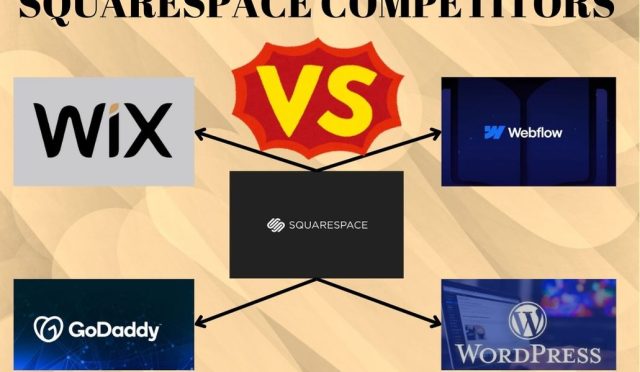Introduction
This analysis explores the competitive landscape in which NVIDIA Corporation (NVDA) operates. NVIDIA faces competition from a mix of established semiconductor companies, specialized graphics processing unit (GPU) designers, and emerging players in the artificial intelligence (AI) and high-performance computing (HPC) space. Understanding the strengths and weaknesses of these NVIDIA competitors is crucial for businesses and investors seeking to navigate the rapidly evolving world of computing technology.
The GPU and AI Revolution
NVIDIA is the leading designer of GPUs, specialized electronic circuits that accelerate the creation of images, videos, and other visual content. GPUs have become essential for various applications, including gaming, data centers, AI, and autonomous vehicles. NVIDIA’s GPUs, particularly its GeForce and Tesla lines, are widely recognized for their high performance and advanced capabilities. However, the GPU and AI landscape is dynamic and competitive, with several companies vying for market share and technological leadership.
Key NVIDIA Competitors
This section will delve deeper into some of the most prominent NVIDIA competitors:
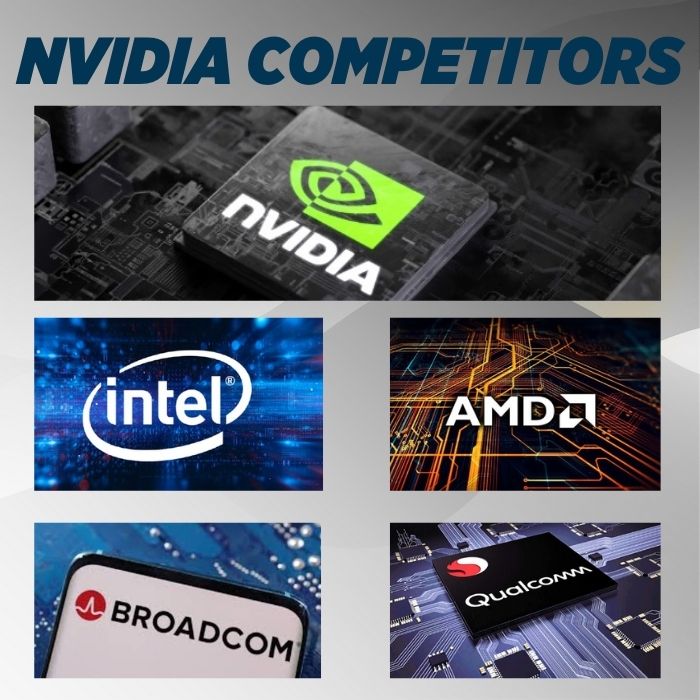
Company Overview
| Feature | NVIDIA | AMD | Intel | Qualcomm | Broadcom |
| Founded | 1993 | 1969 | 1968 | 1985 | 1961 (as Avago Technologies) |
| Founder(s) | Jensen Huang, Chris Malachowsky, Curtis Priem | Jerry Sanders III | Robert Noyce & Gordon Moore | Irwin Jacobs, Andrew Viterbi, et al. | (various mergers) |
| CEO | Jensen Huang | Lisa Su | Pat Gelsinger | Cristiano Amon | Hock Tan |
| Mission | To solve the world’s most challenging problems with accelerated computing. | To be the world’s leading high-performance computing company. | To create world-changing technology that enriches the lives of every person on earth. | To enable the connected intelligent edge. | To connect everything. |
| Employees | ~29,000 | ~15,000 | ~130,000 | ~51,000 | ~20,000 |
| Headquarters | Santa Clara, California, USA | Santa Clara, California, USA | Santa Clara, California, USA | San Diego, California, USA | San Jose, California, USA |
Market Share (Approximate) of the Nvidia Competitors
Discrete GPUs:
- NVIDIA: ~80% (dominant player in the discrete GPU market)
- AMD: ~20%
Data Center GPUs:
- NVIDIA: ~70% (leading provider of GPUs for AI and HPC)
- AMD: ~15%
- Intel: ~5%
Gaming GPUs:
- NVIDIA: ~75% (strong presence in gaming)
- AMD: ~25%
Product Range of the Nvidia Competitors
NVIDIA:
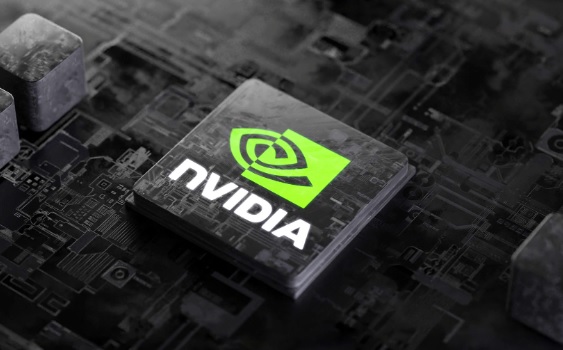
- GeForce GPUs (gaming)
- Tesla GPUs (data centers, AI)
- Quadro GPUs (professional visualization)
- Jetson (embedded AI platforms)
- DRIVE (autonomous vehicle platforms)
- NVIDIA AI Enterprise (software suite)
AMD:
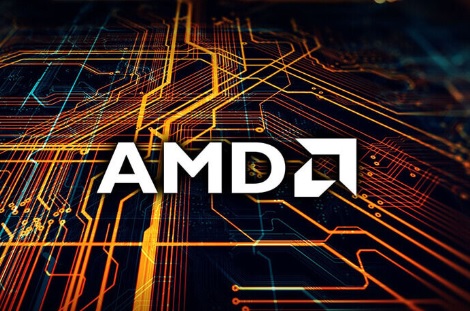
- Radeon GPUs (gaming)
- Instinct GPUs (data centers, AI)
- Ryzen CPUs (central processing units)
- EPYC CPUs (server processors)
Intel:
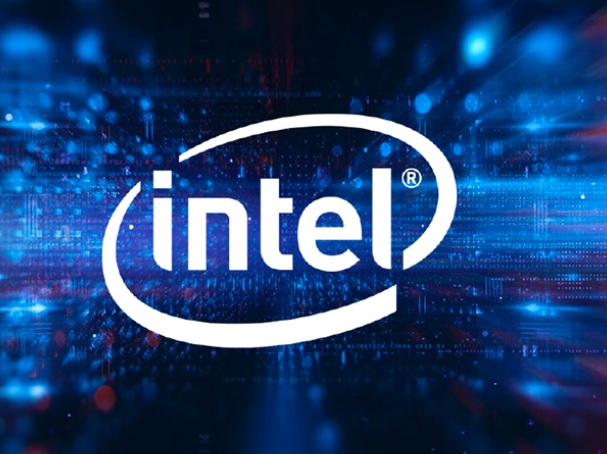
- Integrated GPUs (included with Intel CPUs)
- Arc GPUs (discrete graphics)
- Xeon CPUs (server processors)
- Habana Gaudi AI accelerators
Qualcomm:
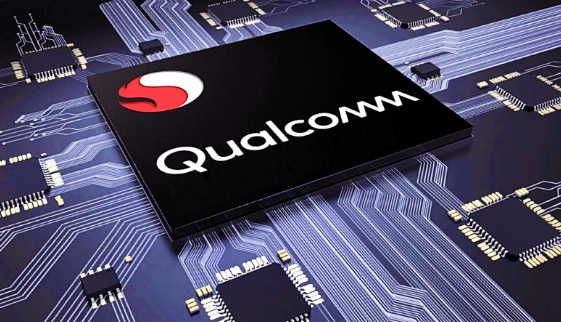
- Snapdragon chipsets (mobile devices)
- Adreno GPUs (mobile graphics)
- Snapdragon platforms for automotive and IoT
Broadcom:

- Networking chips
- Broadband processors
- Storage controllers
- Various semiconductor solutions
Strengths and Weaknesses of the Nvidia Competitors
NVIDIA:
- Strengths: Dominant market share in GPUs, strong brand recognition, focus on high-growth markets like AI and data centers, and a comprehensive software ecosystem.
- Weaknesses: High product prices, dependence on the gaming market, and increasing competition from AMD and Intel.
AMD:
- Strengths: Competitive pricing, strong performance in CPUs and GPUs, and a growing presence in the data center market.
- Weaknesses: Smaller scale compared to NVIDIA, and less established brand recognition in some markets.
Intel:
- Strengths: Vast manufacturing capacity, strong brand recognition, and a large installed base of Intel-powered devices.
- Weaknesses: Late entry to the discrete GPU market, limited track record in high-performance graphics, and challenges in competing with NVIDIA’s and AMD’s established positions.
Qualcomm:
- Strengths: Leading position in the mobile chipset market, expertise in wireless technologies, and a diversified product portfolio.
- Weaknesses: Dependence on the smartphone market, increasing competition from other mobile chipset providers, and limited presence in the data center and AI markets.
Broadcom:
- Strengths: Diversified product portfolio, strong customer relationships, and a history of successful acquisitions.
- Weaknesses: Less focus on GPUs and AI compared to NVIDIA and AMD, and potential challenges in integrating acquired companies.
Investments and Future Plans of the Nvidia Competitors
- NVIDIA: Investing in new GPU architectures, expanding its AI software platform, and developing solutions for the metaverse and autonomous vehicles.
- AMD: Investing in high-performance CPUs and GPUs, expanding its data center presence, and developing new technologies like chiplet-based processors.
- Intel: Investing heavily in its GPU business, expanding its foundry services, and developing new AI and HPC solutions.
- Qualcomm: Expanding its 5G and wireless technology offerings, developing new platforms for automotive and IoT, and investing in AI research.
- Broadcom: Continuing its acquisition strategy, investing in new semiconductor technologies, and expanding its presence in data centers and networking.
Head-to-Head Comparison of the Nvidia Competitors
- NVIDIA vs. AMD: NVIDIA is the dominant player in GPUs with a stronger brand and larger market share, while AMD offers competitive pricing and strong performance in both CPUs and GPUs.
- NVIDIA vs. Intel: NVIDIA is the established leader in discrete GPUs, while Intel is a newer entrant with a strong focus on integrated graphics and a growing presence in discrete GPUs.
- NVIDIA vs. Qualcomm: NVIDIA focuses on high-performance GPUs for gaming, data centers, and AI, while Qualcomm specializes in mobile chipsets and wireless technologies.
Consumer Experiences and Preferences of the Nvidia Competitors
- Performance: Gamers and professionals often prioritize GPU performance for demanding tasks. NVIDIA is generally recognized for its high-performance GPUs, but AMD has been closing the gap in recent years.
- Price: Price can be a significant factor for consumers. AMD often offers more competitive pricing compared to NVIDIA, while NVIDIA’s high-end GPUs command a premium.
- Features: Different users have varying needs and preferences for features. NVIDIA offers a comprehensive software ecosystem and advanced features like ray tracing, while AMD focuses on delivering strong performance and value.
- Availability: Product availability can be a concern, especially for high-demand GPUs. Both NVIDIA and AMD have faced supply chain challenges in recent years.
Customer Satisfaction of the Nvidia Competitors
- NVIDIA: Generally receives positive customer feedback for its high-performance GPUs and software ecosystem, but some users have expressed concerns about high prices and driver issues.
- AMD: Customer satisfaction has been improving as AMD has gained market share and delivered competitive products, with positive feedback for its pricing and performance.
- Intel: Customer satisfaction with its GPUs has been mixed, as it is a newer entrant to the market, but its integrated graphics are widely used and generally well-regarded.
Conclusion
NVIDIA is a dominant force in the GPU market, but it faces increasing competition from AMD, Intel, and other players. The company’s focus on high-performance computing, AI, and emerging technologies like the metaverse positions it for continued growth. However, investors and businesses should carefully monitor the competitive landscape and NVIDIA’s ability to maintain its technological leadership and adapt to changing market dynamics. If you liked this review, you can also review our article about other Technology posts here.
FAQ About NVIDIA
What is NVIDIA?
NVIDIA Corporation is a leading American technology company primarily known for designing graphics processing units (GPUs) for gaming, professional visualization, data centers, and AI applications. Founded in 1993, NVIDIA has become a dominant player in the semiconductor industry.
What are the main products offered by NVIDIA?
NVIDIA’s main products include:
- GeForce GPUs: Designed for gaming and consumer graphics.
- Tesla GPUs: Targeted at data centers and AI workloads.
- Quadro GPUs: Professional visualization solutions for design and engineering.
- Jetson: Embedded AI platforms for robotics and IoT.
- DRIVE: Solutions for autonomous vehicles.
- NVIDIA AI Enterprise: A software suite for AI development and deployment.
Who are NVIDIA’s main competitors?
NVIDIA’s primary competitors include:
- AMD (Advanced Micro Devices): Known for its Radeon GPUs and Ryzen CPUs.
- Intel: Offers integrated GPUs and is expanding into discrete graphics with its Arc series.
- Qualcomm: Focuses on mobile chipsets and Adreno GPUs.
- Broadcom: Provides a range of semiconductor solutions, though less focused on GPUs.
What is NVIDIA’s market share in the GPU industry?
As of recent estimates:
- Discrete GPUs: NVIDIA holds approximately 80% of the market.
- Data Center GPUs: NVIDIA commands around 70% of this segment.
- Gaming GPUs: NVIDIA has about 75% market share in gaming graphics.
What are NVIDIA’s strengths?
NVIDIA’s strengths include:
- Dominant market share in GPUs.
- Strong brand recognition and reputation for high performance.
- Comprehensive software ecosystem supporting AI and gaming.
- Continuous innovation in GPU architecture and AI technologies.
What are some weaknesses of NVIDIA?
Some weaknesses include:
- High product prices compared to competitors.
- Dependence on the gaming market for a significant portion of revenue.
- Increasing competition from AMD and Intel.
How does NVIDIA contribute to AI technology?
NVIDIA is a key player in AI technology through:
- Development of GPUs optimized for AI workloads.
- The creation of software frameworks like CUDA for parallel computing.
- Investment in AI research and partnerships with leading tech companies and research institutions.
What is NVIDIA’s role in gaming?
NVIDIA plays a crucial role in gaming by providing high-performance GPUs that enhance graphics quality and performance. Their technologies, such as Ray Tracing and DLSS (Deep Learning Super Sampling), improve visual fidelity and frame rates, making gaming experiences more immersive.
How does NVIDIA support developers?
NVIDIA supports developers through:
- Comprehensive SDKs (Software Development Kits) and APIs (Application Programming Interfaces).
- Developer forums and resources for troubleshooting and optimization.
- Training programs and workshops to enhance skills in AI, gaming, and graphics development.
What are NVIDIA’s future plans?
NVIDIA is focused on:
- Expanding its AI and machine learning capabilities.
- Developing new GPU architectures.
- Investing in the metaverse and autonomous vehicle technologies.
- Enhancing its software offerings to support emerging technologies.
How can I contact NVIDIA for support?
For support, users can visit the NVIDIA Support page on their official website, where they can find resources, submit support tickets, and access community forums for assistance.

